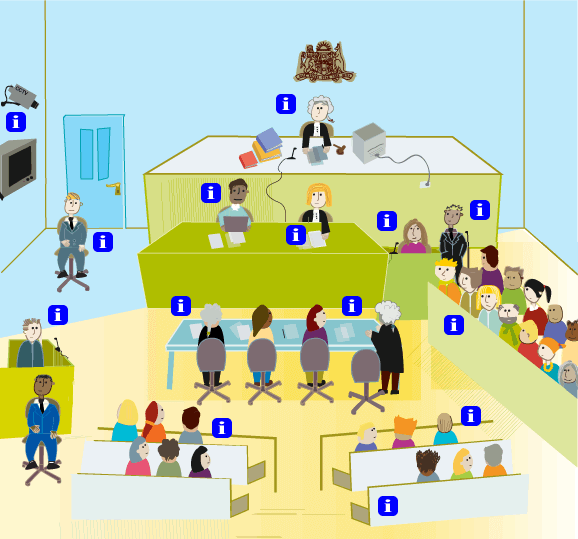Roles in court
Ever wondered what a court room looks like in a criminal trial when there's a jury?

The diagram above shows the main players in a criminal trial by jury in the district or supreme court. Click on the different areas of the diagram to find out who's who in court or read below descriptions for each person.
Accused person
Someone who is charged with a crime. Accused people can represent themselves, but can also have a solicitor or barrister represent them. Accused people usually sits in a section called the dock, or behind the bar table.
Court reporter or transcriber
Court staff member who records the hearing and writes down or types what is being said.
Closed circuit television
Used to convey images of court proceedings to another location when a person is giving evidence from a remote witness facility, or is appearing in court from another location via video conferencing.
Court officer
Helps the judicial officer and people coming into the courtroom. He (or she) organises court lists, calls witnesses and administers oaths.
Corrective service officer
Provides transport and security for people in custody.
Defendant
Person who must defend his or her actions in court. Defendants may be defending themselves against a criminal or civil charge or have had a court claim for money brought against them. In a criminal trial, a defendants is called the accused.
Defence lawyer
Represents the defendant or accused person. Sometimes several defence lawyers represent the accused person. In the district or supreme courts the defence barrister may wear a wig and gown.
Interpreter
Assists the court by translating speech from one language into another or by translating sign language into speech.
Judge or judicial officer
In the district court and supreme court, the judicial officer is called a judge. In the local court the judicial officer is a magistrate. You call a judicial officer 'Your Honour' when you are in court.
Judge's associate
Helps the judge in court with documents and exhibits used in the case.
Jurors
Citizens who sit on a jury panel and consider the evidence in court and decide on matters of fact. Jury panel members are selected at random from the public. They deliver a verdict on the case. In criminal cases there is a jury of 12 while in some civil cases there is a jury of four people. In the local court, cases are heard without a jury.
Media
Representatives from the press, television and online services can attend most court proceedings, except those in the children's court.
Prosecutor
Represents the police or state in criminal matters. In the local court, the prosecutor is a specially trained police officer while in the district or supreme court, the prosecutor is a lawyer from the Office of the Director of Public Prosecutions.
Public
Public are allowed into the public galleries of courtrooms in New South Wales to watch most cases. However, some cases, including all children's court cases, are closed to the public.
Support people
Come to court to offer support to particular witnesses. They are chosen by particular witnesses, but do not play a role in court proceedings.
Witness
Someone who gives evidence in a case. Witnesses answer questions asked by the prosecutor and the defence. Before giving evidence, each witness is asked to take an oath or affirmation, which is a promise to tell the truth.
Last updated:
04 Dec 2023
We acknowledge the traditional owners and custodians of the land on which we work and we pay respect to the Elders, past, present and future.